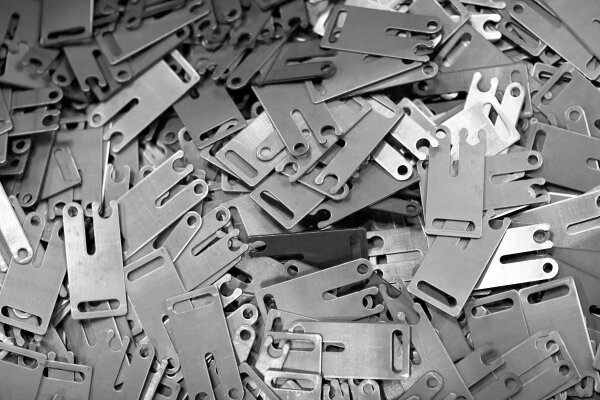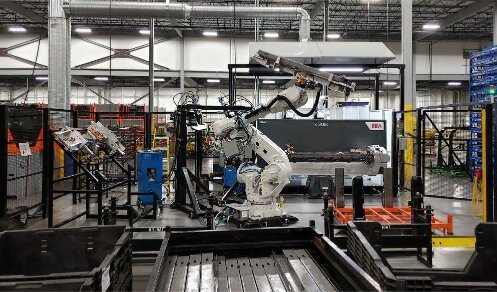Większość ludzi nie zastanawia się nad tym, w jaki sposób wytwarzane są metalowe części w ich produktach - dopóki sami nie będą potrzebować niestandardowych części. Wtedy zaczyna się zamieszanie. Znalezienie niezawodnego warsztatu, który zapewnia jakość i szybkość, może wydawać się przytłaczające. Możesz nie wiedzieć, co dzieje się w warsztacie produkcyjnym lub czego się spodziewać. Ale gdy zrozumiesz, jak działają te sklepy, wybór właściwego będzie łatwiejszy.
Sprawdźmy, co dzieje się w tych warsztatach i dlaczego są one kluczowe dla wielu branż. Możesz być zaskoczony, jak bardzo wpływają one na codzienne życie.

Czym jest warsztat obróbki metali?
Warsztat produkcji metalowej to miejsce pracy, w którym kształtuje się części metalowe. Wykorzystuje on cięcie, gięcie, spawanie i montaż w celu przekształcenia blachy lub metalu konstrukcyjnego w produkty końcowe. Pracownicy postępują zgodnie z rysunkami technicznymi i używają narzędzi takich jak wycinarki laserowe, prasy krawędziowe i spawarki MIG.
Większość sklepów przyjmuje projekt klienta i zajmuje się wszystkim - od surowców po gotowe produkty. Ich praca może obejmować jednorazowe prototypy, małe partie lub produkcję wielkoseryjną. Skupiają się na dokładności, szybkości i jakości.
Różnica między warsztatami produkcyjnymi a warsztatami maszynowymi
Warsztaty produkcyjne i warsztaty maszynowe pracują z metalem, ale używają różnych metod.
Zakłady produkcyjne kształtują metal przy użyciu siły fizycznej, takiej jak cięcie, spawanie lub gięcie. Budują rzeczy z arkuszy, prętów i rur.
Warsztaty maszynowe usuwają materiał. Używają frezarek CNC, tokarek i szlifierek do rzeźbienia części z litych bloków.
Mówiąc najprościej, produkcja buduje, podczas gdy obróbka skrawaniem zmniejsza. Niektóre nowoczesne warsztaty wykonują obie te czynności, ale ich podstawowe procesy i narzędzia różnią się od siebie.
Typowe rodzaje warsztatów produkcyjnych
Nie wszystkie zakłady produkcyjne wykonują taką samą pracę. Każdy z nich specjalizuje się w innych materiałach, procesach lub branżach. Oto ich podział.
Warsztaty blacharskie
Skupiają się one na ciąć, zginaniei łączenie blach. Typowe zadania obejmują obudowy, nawiasyoraz szafki.
Sklepy ze stalą konstrukcyjną
Budują belki, kolumny i ciężkie ramy, a ich części są często wykorzystywane w budynkach, mostach lub maszynach.
Warsztaty spawalnicze
Specjalizują się one w łączeniu metalowych części. Niektóre sklepy wykonują tylko spawanie dla innych producentów.
Niestandardowe warsztaty pracy
Podejmują się unikalnych lub jednorazowych prac. Sklepy te ściśle współpracują z klientami, aby spełnić określone potrzeby projektowe.
Warsztaty produkcyjne z pełnym zakresem usług
Robią wszystko po trochu - projektują, prototypowanie, cięcie laserowe, spawanie, wykończeniowyoraz montaż. Obsługują cały proces produkcji pod jednym dachem.

Czym zajmują się warsztaty produkcyjne?
Zakłady produkcyjne przekształcają surowce w funkcjonalne części. Oto jak to robią, krok po kroku.
Ciąć
Cięcie jest zazwyczaj pierwszym krokiem. Kształtuje ono surowiec na mniejsze, użyteczne kawałki.
Sklepy używają narzędzi takich jak wycinarki laserowe, wycinarki plazmowe i nożyce, które szybko i precyzyjnie tną blachy, rury lub pręty.
Cięcie laserowe jest standardem w przypadku czystych krawędzi i szczegółowych prac. Cięcie plazmowe dobrze sprawdza się w przypadku grubszych materiałów. Nożyce są najlepsze do prostych, szybkich cięć.
Formowanie i gięcie
Po cięciu metal często wymaga wygięcia lub ukształtowania.
Sklepy używają do tego pras krawędziowych i rolek. Prasa krawędziowa dociska metal do kształtu przy użyciu siły i matrycy. Walce wyginają metal w łuki lub cylindry.
Na tym etapie powstają kąty, zagięcia i krzywizny ostatecznego projektu. Dokładne gięcie ma kluczowe znaczenie dla dopasowania i funkcjonalności części.
Spawalniczy
Spawanie łączy dwa lub więcej elementów metalowych. Ten krok jest konieczny, gdy części nie mogą być wykonane z pojedynczego arkusza lub pręta.
Powszechnie stosowane są metody MIG, TIG i spawanie punktowe. Każde z nich jest używane w inny sposób, w zależności od rodzaju materiału, grubości części i projektu.
Dobre spoiny są mocne i czyste. Utrzymują części razem, spełniając jednocześnie wymogi wizualne i bezpieczeństwa.
Obróbka
Niektóre części wymagają wąskich tolerancji lub szczegółowych elementów. W takim przypadku z pomocą przychodzi obróbka skrawaniem.
Obróbka skrawaniem polega na usuwaniu niewielkich ilości metalu w celu wykonania otworów, szczelin lub gładkich powierzchni. Zakłady produkcyjne mogą korzystać z wiertarek, frezarek lub tokarek.
Ten etap jest często stosowany po spawaniu lub gięciu. Zapewnia, że część spełnia dokładne wymagania dotyczące rozmiaru i kształtu.
Montaż
Po wycięciu, wygięciu, zespawaniu i obrobieniu części są one składane w całość.
Montaż może obejmować wkręty, nity, śruby lub spawy. Niektóre sklepy dodają elektronikę, zawiasy lub panele.
Kompletny zespół daje klientowi gotowy do użycia produkt lub podzespół. Oszczędza to czas i zmniejsza zapotrzebowanie na dodatkowych dostawców.
Wykończeniowy
Wykończenie chroni część i poprawia jej wygląd.
Sklepy mogą polski, farba proszkowafarba lub anodować powierzchni. Niektóre wykończenia zwiększają odporność na korozję. Inne nadają gładki lub błyszczący wygląd.
Wykończenie obejmuje również gratowanie i czyszczenie w celu usunięcia ostrych krawędzi lub zabrudzeń. Ten ostatni etap pomaga spełnić standardy jakości i potrzeby użytkowników.
Narzędzia i sprzęt używany w warsztatach produkcyjnych
Zakłady produkcyjne wykorzystują specjalistyczny sprzęt do przekształcania surowców w precyzyjne części. Oto spojrzenie na kluczowe maszyny, które sprawiają, że tak się dzieje.
Narzędzia tnące
Najpopularniejsze typy to wycinarki laserowe, plazmowe i strumieniowe. Wycinarki laserowe są precyzyjne i czyste i najlepiej nadają się do szczegółowych kształtów. Wycinarki plazmowe szybko radzą sobie z grubszymi metalami. Wycinarki wodne tną bez użycia ciepła, dzięki czemu nadają się do delikatnych materiałów.
Sprzęt do formowania
Prasy krawędziowe wyginają blachy pod kątem lub w łuki. Walce kształtują metal w okrągłe lub zakrzywione formy. Maszyny te wykorzystują nacisk do formowania materiału bez jego pękania.
Maszyny spawalnicze
Spawarki MIG, TIG i punktowe są standardem. Metoda MIG jest szybka i odpowiednia do ogólnych prac. TIG oferuje lepszą kontrolę w przypadku cienkich lub delikatnych części. Spawanie punktowe jest często stosowane w pracach blacharskich.
Narzędzia do obróbki skrawaniem
Frezarki i tokarki CNC usuwają materiał w celu uzyskania szczegółowych części lub części o wąskiej tolerancji. Wiertarki, gwintownice i szlifierki pomagają wykańczać powierzchnie lub tworzyć otwory.
Narzędzia montażowe
Należą do nich nitownice, klucze dynamometryczne, zaciski i narzędzia ręczne. Niektóre warsztaty używają uchwytów do przytrzymywania części podczas spawania lub montażu.
Narzędzia do wykańczania
Maszyny do gratowania, szlifierki i tarcze polerskie wygładzają krawędzie i poprawiają jakość powierzchni. Systemy powlekania, takie jak kabiny do malowania proszkowego lub pistolety malarskie, dodają warstwy ochronne.

Co powstaje w zakładach produkcyjnych?
Zakłady produkcyjne wytwarzają niezliczone przedmioty, z których korzystamy na co dzień. Przyjrzyjmy się najpopularniejszym kategoriom produktów.
Elementy konstrukcyjne dla budownictwa
Tworzą one kości budynków i infrastruktury:
- Stalowe belki dwuteowe do drapaczy chmur
- Kratownice wspierające most
- Schody i balustrady
- Ramy platform przemysłowych
Obudowy i szafy dla elektroniki
Precyzyjna metalowa obudowa chroni wrażliwy sprzęt:
- Szafy serwerowe dla centrów danych
- Elektryczne panele sterowania
- Obudowy urządzeń medycznych
- Wiaty na sprzęt telekomunikacyjny
Części samochodowe i lotnicze
Wytrzymałe, lekkie komponenty do pojazdów:
- Ramy i wsporniki podwozia
- Elementy układu wydechowego
- Panele wewnętrzne samolotu
- Części komory silnika
Niestandardowe prototypy i małe serie
Specjalistyczne rozwiązania dla unikalnych potrzeb:
- Jednorazowe części maszyn
- Prototypy rozwoju produktu
- Komponenty zamienne dla starszych urządzeń
- Limitowane serie produkcyjne
Jak działają warsztaty produkcyjne?
Zakłady produkcyjne przestrzegają precyzyjnego przepływu pracy, aby zapewnić jakość i wydajność. Oto typowy proces krok po kroku.
Wycena i przegląd projektu
Proces rozpoczyna się, gdy klient prześle rysunek lub model 3D. Sklep sprawdza projekt pod kątem wykonalności i wykorzystania materiałów.
Następnie przygotowują ofertę, która obejmuje koszt, czas realizacji i etapy procesu. Sklepy mogą zasugerować zmiany w celu poprawy funkcjonalności lub obniżenia kosztów.
Inżynieria i planowanie materiałowe
Po zatwierdzeniu zamówienia zespół inżynierów przygotowuje szczegółowe pliki, które prowadzą maszyny i pracowników przez proces cięcia, gięcia i spawania.
W tym samym czasie sklep zamawia surowce i planuje pracę. Ten krok zapewnia, że wszystko jest gotowe w momencie rozpoczęcia produkcji.
Produkcja i kontrole jakości
Teraz warsztat rozpoczyna cięcie, formowanie, spawanie i obróbkę. Pracownicy ściśle przestrzegają rysunków. Maszyny są ustawiane z dokładnymi wartościami rozmiaru i kształtu.
Kontrole jakości odbywają się na każdym etapie. Technicy sprawdzają pomiary, spoiny i wykończenie powierzchni, aby zapobiec rozwojowi błędów.
Pakowanie i dostawa
Gdy część jest gotowa i zatwierdzona, trafia do pakowania. Sklep zabezpiecza przedmiot za pomocą pianki, plastikowej folii lub skrzynek.
Części są etykietowane, ładowane i wysyłane zgodnie z instrukcjami klienta. Niektóre sklepy oferują lokalną dostawę, podczas gdy inne wysyłają na cały świat.

Ludzie stojący za metalem
Każdy warsztat produkcyjny opiera się na współpracy wykwalifikowanych specjalistów. Oto, kto i co robi, aby Twoje części były wykonane prawidłowo.
Spawacze, wytwórcy i mechanicy
Ci praktyczni eksperci pracują bezpośrednio z materiałami:
- Spawacze łączenie metalu przy użyciu różnych technik (MIG, TIG, sztyft)
- Producenci obsługa pras krawędziowych, walcarek i maszyn tnących
- Maszyniści Obsługa operacji wiercenia, frezowania i wykańczania
- Wszyscy postępują zgodnie ze szczegółowymi instrukcjami pracy i planami
Inżynierowie i projektanci
Rozwiązywanie problemów technicznych:
- Inżynierowie projektanci przekształcanie koncepcji w projekty nadające się do produkcji
- Inżynierowie procesu określić najlepsze metody produkcji
- Technicy CAD tworzenie szczegółowych modeli cyfrowych
- Specjaliści od gniazdowania Optymalizacja zużycia materiałów
Inspektorzy jakości i kierownicy projektów
Opiekunowie jakości i osi czasu:
- Inspektorzy weryfikacja wymiarów przy użyciu suwmiarek, współrzędnościowych maszyn pomiarowych i przyrządów pomiarowych
- Menedżerowie ds. kontroli jakości utrzymywanie standardów ISO i innych standardów jakości
- Kierownicy projektów koordynowanie przepływu pracy i terminów
- Funkcjonariusze ds. bezpieczeństwa zapewnienie zgodności z przepisami OSHA
Personel łańcucha dostaw i logistyki
Zakulisowi organizatorzy:
- Agenci zakupów Pozyskiwanie surowców po najlepszych cenach
- Menedżerowie zapasów śledzenie poziomów zapasów
- Koordynatorzy wysyłki zorganizować terminowe dostawy
- Przedstawiciele obsługi klienta obsługa aktualizacji zamówień i zapytań
Jak wybrać odpowiedni zakład produkcyjny?
Wybór odpowiedniego zakładu produkcyjnego wpływa na koszty, czas realizacji i jakość produktu. Dobry zakład dopasowuje się do potrzeb technicznych i działa jak partner - a nie tylko dostawca. Oto kluczowe rzeczy, które należy sprawdzić przed podjęciem decyzji.
Doświadczenie i certyfikaty
Zacznij od ich doświadczenia. Jak długo działają na rynku? Czy mają doświadczenie z danym typem części lub branżą?
Certyfikaty takie jak ISO 9001, AWS lub AS9100 pokazują, że zakład przestrzega rygorystycznych systemów jakości. Ma to większe znaczenie w branżach takich jak lotnictwo czy medycyna.
Poszukaj zespołu, który rozumie zarówno projektowanie, jak i produkcję. Pomoże to uniknąć błędów i ulepszyć produkt.
Sprzęt i możliwości
Upewnij się, że warsztat dysponuje odpowiednimi maszynami. Nie wszystkie warsztaty mogą obsługiwać grube płyty, precyzyjne cięcia lub wąskie tolerancje.
Zapytaj o ich wycinarki laserowe, prasy krawędziowe, maszyny CNC i narzędzia wykończeniowe. Im więcej usług wykonują we własnym zakresie, tym szybciej i sprawniej przebiegnie realizacja projektu.
Sprawdź, czy mogą się skalować. Jeśli twój prototyp stanie się dużym zamówieniem, chcesz, aby mogli nadążyć.
Czas realizacji i komunikacja
Szybka obsługa działa tylko wtedy, gdy sklep pozostaje w kontakcie. Zapytaj, jak długo trwa wycena. Sprawdź, czy zapewniają aktualizacje po rozpoczęciu pracy.
Sklepy, które szybko reagują i są łatwiejsze we współpracy. Są one również bardziej skłonne do usuwania problemów na wczesnym etapie, a nie po dostawie.
Solidny sklep równoważy szybkość z dokładnością. Nie spieszą się kosztem jakości.
Portfolio i opinie klientów
Poproś o zdjęcia lub próbki wcześniejszych prac. Pozwoli ci to zorientować się w zakresie prac artysty i jakości wykończenia.
Sprawdź recenzje online lub poproś o referencje. Dobre sklepy będą miały stałych klientów i pozytywne opinie.
Obsługa klienta, dbałość o szczegóły i niezawodna dostawa są równie ważne jak ich maszyny.
Wnioski
Warsztat produkcyjny to miejsce, w którym surowy metal staje się rzeczywistym produktem. Zajmuje się cięciem, gięciem, spawaniem, obróbką skrawaniem i montażem - wszystko pod jednym dachem. Sklepy te obsługują takie branże jak budownictwo, elektronika, motoryzacja i lotnictwo.
Każdy sklep opiera się na wykwalifikowanych zespołach, potężnych narzędziach i przepływach pracy krok po kroku. Od wyceny po dostawę, każdy krok koncentruje się na dokładności, szybkości i potrzebach klienta.
Potrzebujesz szybko i prawidłowo wykonać części metalowe? Wyślij nam swoje rysunki lub pomysły-Sprawdzimy je i otrzymamy dokładną wycenę z szybką realizacją. Żadnego zgadywania. Tylko proste odpowiedzi i wysokiej jakości wyniki.
Hej, jestem Kevin Lee

Przez ostatnie 10 lat byłem zanurzony w różnych formach produkcji blach, dzieląc się tutaj fajnymi spostrzeżeniami z moich doświadczeń w różnych warsztatach.
Skontaktuj się z nami

Kevin Lee
Mam ponad dziesięcioletnie doświadczenie zawodowe w produkcji blach, specjalizując się w cięciu laserowym, gięciu, spawaniu i technikach obróbki powierzchni. Jako dyrektor techniczny w Shengen, jestem zaangażowany w rozwiązywanie złożonych wyzwań produkcyjnych i napędzanie innowacji i jakości w każdym projekcie.




